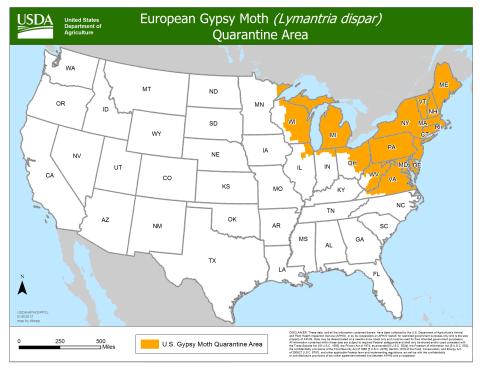Memorial Day Weekend means hitting the road for many of us – vacations, camping, or even moving to a new home. But watch out for an invasive pest that also enjoys new destinations—the destructive gypsy moth. Gypsy moth caterpillars can defoliate, weaken and kill more than 300 different species of trees and shrubs. Since 1970, more than 83 million acres have been defoliated by the gypsy moth in the U.S.
This destructive insect is always interested in a free ride to new locales where its caterpillars can feast. And Americans are on the move in May—that’s why it’s National Moving Month—giving gypsy moths plenty of opportunities to spread.
Residential moves account for 85 percent of all new gypsy moth infestations, and approximately 40 million Americans will relocate their households this year. Slowing the movement of the gypsy moth is the reason the U.S. Department of Agriculture asks homeowners to inspect for and remove gypsy moth egg masses from household goods before they move from an infested area to a non-infested area.
Female gypsy moths often lay their eggs on outdoor household goods like barbecue grills, deck furniture, lawn equipment, and trailers, so take some extra care when packing so those egg masses don’t move with you. It’s easy to leave gypsy moths behind: during your vehicle and outdoor household item inspection, look for a dense mass of tan or buff colored hairs resembling a small piece of a camel hair sweater. Remove it with a putty knife or stiff brush, and dispose of it in a container of hot soapy water—that’s it!
The USDA’s Animal and Plant Health Inspection Service (APHIS) and key partners are working hard to stop the gypsy moths, working closely with the Gypsy Moth Slow the Spread Foundation (10 states located along the leading edge of gypsy moth populations).
Even if you’re not relocating your household this month, you may be planning a getaway for the long Memorial Day holiday weekend. A close inspection of your travel trailer, boat, and all outdoor toys is a must before leaving the driveway. It’s vital because a single gypsy moth egg mass hidden under an RV bumper could contain up to 1,000 individual eggs. That means your carefree holiday could have unintended and disastrous consequences—establishing a new infestation! If you find an egg mass, remove it right away.
If you’re planning to move, you’ll want to visit YourMoveGypsyMothFree.com for more information. It will help you to understand if you must complete an inspection checklist for your outdoor household items and take it with you during your move.
Protect your destinations from the destructive potential of the gypsy moth. Fortunately, a simple inspection is all it takes to stop this pest in its tracks.






